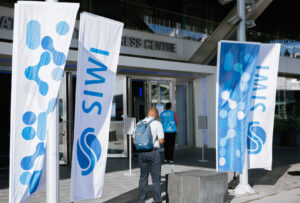WWW 2014 – First Impressions
She stated that, ‘Christians go to Jerusalem annually and Muslims go to Mecca for the Haj and the Water people go to Stockholm.’ Truly the World Water Week has become the place for discussions by the leading practitioners, academics and policy makers on critical issues and challenges facing the world.
This year the common word used is Nexus. This is the interdependencies of Water, Energy, food and ecosystems. It is impossible to think about one without the other, yet so far they have often been placed in silos in different Ministries with very little coordination between the two in planning and policy making.
Globally the numbers behind the two sectors are staggering, 768 million people without access to improved water supply, 2.5 billion people without access to improved sanitation and about 1.2 billion without access to electricity. This alone should be cause for alarm, coming as it does at the borderline of the MDG target year of 2015. For India, my home country, the numbers are equally staggering, about 96 million people without access to improved water supply, about 600 million without access to improved sanitation and about 400 million people without access to electricity.
However, matters are likely to be rectified with the Sustainable Development Goals, which will focus on Sustainability issues and will look at energy access, which was missed completely by the MDGs. The World Development Report for 2014 captures these numbers and challenges in great detail. For example the demand for water is likely to go up 55 % in the next 30 years and energy by 50 % in the next 20 years.
The other challenge is one of subsidies in each of the sectors. Energy subsidies are estimated at $ 544 Billion and at 2012 prices including externalities, it is a staggering $ 1.9 Trillion (Tome Moerenhout -IISD) these funds are unfortunately badly targeted and do not reach the poorest. Then there is the gorilla in the room – climate change. How this will impact the Nexus is still a matter of conjecture and much more science needs to be thrown in before a fuller understanding emerges. Suffice to say that the impacts will be mostly negative.
The World Water Week also sees many groups presenting their work in the exhibition stalls. One very interesting stall is on the Murray-Darling basin in Australia, where through complex negotiation between various states and water users a river basins ecosystem health is being restored. This approach at a basin level for the nexus issues seems a good way to progress and much can be learnt from the Murray-Darling basin.
The eThekwini water utility which provides water to the eThekwini municipality in South Africa won this year’s Stockholm Industry Water Award. It has tried a series of innovative efforts in what it calls ‘Nexus- from theory to practice’, including such innovative projects as faecal sludge management, landfill gas to electricity, wastewater reuse for potable purpose, nutrient recovery from wastewater, community gardens and so on. This is clearly showing a path to what would be called Integrated Urban Water Management.
There is a caveat to the argument for success stories such as that of the Murray-Darling basin and the eThekwini Municipality examples, as the winner of this year’s World Water Prize Dr John Briscoe mentions, most solutions are local and most solutions are provisional. Wise words, coming from a practitioner of eminence and experience.
In the effort to manage water and energy sustainable platforms such as the World Water Week is crucial for the conversations they generate and the ideas tested with a peer group. More power then to SIWI and Stockholm for a continuation of this dialogue!








